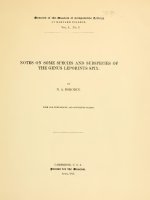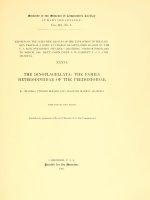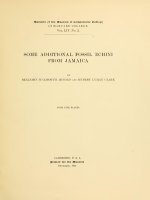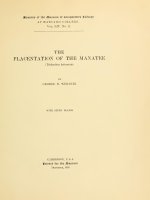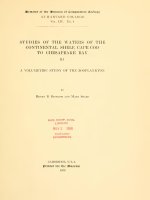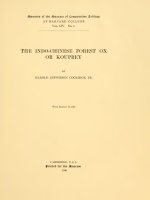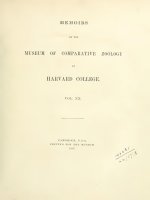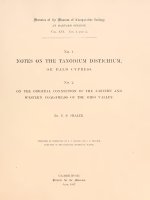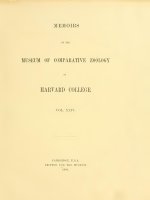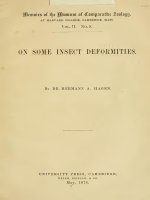Memoirs MCZ 5401
Bạn đang xem bản rút gọn của tài liệu. Xem và tải ngay bản đầy đủ của tài liệu tại đây (11.75 MB, 223 trang )
/IDemotrs of tbe /iDuseum ot Comparattve ZooloGt»
AT HARVARD COLLEGE.
Vol. LIV, No.
1.
REPORTS ON THE SCIENTIFIC RESULTS OF THE EXPEDITION TO THE EASTERN TROPICAL PACIFIC, IN CHARGE OF ALEXANDER AGASSIZ, BY THE
"
U. S. FISH COMMISSION STEAMER
ALBATROSS," FROM OCTOBER, 1904,
TO MARCH, 1905, LIEUT. -COMMANDER L. M. GARRETT, U. S. N., COMMANDING.
XXXVI.
THE DINOFLAGELLATA: THE FAMILY
HETERODINHDAE OF THE PERIDINIOH^AE.
By CHARLES
ATWOOD KOFOID AND ALASTAIR MARTIN ADAMSON.
WITH TWENTY-TWO PLATES.
[Published by permission of
Henry O'Mallev,
CAMBRIDGE,
U.
S.
U.
S.
Fish Commissioner]
A.
printeD tor tbe /Duseum.
1933.
CONTENTS
REPORTS on the scientific results of the Expedition to the Eastern Tropical Pacific,
of
Alexander
The
charge
Agassiz, by the U. S. Fish Commission Steamer "Albatross,"
October, 1904, to March, 1905, Lieut. -Commander
XXXVI.
in
Dinoflagellata:
the
family
L.
M.
from
Garrett, U.S. N., commanding.
Heterodiniidae of the Peridinioidae.
Charles Atwood Kofoid and Alastair Martin Adamson.
With 22
plates.
By
CONTENTS
Page
PART
PART
.....
Introduction and Collections
I.
Acknowledgments
9
10
Systematic Account
11
family Heterodiniidae
Place of Heterodinium in the Peridinioidae
II
II.
The
....
.....
...
.....
...
...
......
...
....
II
Heterodiniuni Kofoid
Diagnosis
Organology
Reproduction
Occurrence
12
12
12
16
16
.
.
20
Historical discussion
Valid species of Heterodiniidae with
stations
known
istnl ution
Adaptive characters
Relationships
among
the species
Comparisons
Key
to the subgenera of
Heterodinium Kofoid
Subgenus Sphaerodinium Kofoid
Key to the species of the subgenus Sphaerodinium Kofoid
The
kofoidi group
....
....
Heterodinium doma (Murray
H. calvum Kofoid
&
Whitting)
The minutum group
H. minutum Kofoid & Michener
H. obesum Kofoid
H. murrayi Kofoid
H. milneri (Murray
of record
22
24
25
28
29
29
30
30
.
.
and number
30
32
34
34
36
38
&
\Vhitting)
H. superbum Kofoid
H. gloliosum Kofoid
Subgenus Heterodinium nom. subgen. nov.
Key to the species of the subgenus Heterodinium
.
The expansum group
....
....
H. expansum Kofoid
H. angulatum Kofoid
H. spiniferuni Kofoid
&
&
Michener
Michener
H. fenestratum Kofoid
H. praetextum Kofoid
The dispar group
H. dispar sp. nov.
H. elongatum Kofoid & Michener
H. leiorhynchum (Murray & Whitting)
....
....
41
43
45
47
48
48
49
51
52
54
56
58
59
61
64
H. hindmarchii (Murray & Whitting)
Status of H. hindmarchii forma maculatum
66
H. curvatum Kofoid
70
H. blackmani (Murray
&
Whitting)
68
74
CONTENTS
8
Page
The rigdenae group
78
H. rigdenae Kofoid
H. scrippsi Kofoid
78
81
Subgenus Platydinium Kofoid
Key
to the species of the
85
subgenus Platydinium Kofoid
The
pavillardi group
H. agassizi Kofoid
H. fides Kofoid
90
H. whittingae Kofoid
H. laticinctum Kofoid
H. asymnietricum sp. nov.
H. laeve Kofoid
&
85
86
86
92
95
97
Miehener
100
The gesticulatum group
102
H. mediocre (Kofoid)
H. sinistrum sp. nov.
105
102
H. deformatum (Kofoid)
H. gesticulatum (Kofoid)
H. extremum (Kofoid)
113
H. varicator
116
H.
107
109
sp. nov.
scotti sp. nov.
118
Dolichodinium gen. nov.
120
120
Diagnosis
Description
121
Comparisons
121
Synonymy
122
Distribution
122
Reproduction
D. lineatum (Kofoid
122
PART
III.
&
Miehener)
......
122
Distribution ok the Heterodiniidae at the Stations of the
Expedition
125
Bibliography
133
Index
135
INTRODUCTION AND COLLECTIONS
I.
The
family Heterodiniidae comprises a
the Peridinioidae restricted to
number
of relatively rare species of
warm temperate and
tropical seas.
They
are
seemingly a depauperate group occurring mainly in the deeper levels of the illuminated zone. This is illustrated by the fact that only 17, or 7.1%, of our 240
station records of species of this family are from surface hauls.
tom on
the Expedition to the Eastern Tropical Pacific to
with No. 12 and No. 25
The
silk nets.
make
It
was the cus-
subsurface hauls
nets were lowered with the ship at slow
speed to an estimated depth of 300 fathoms, towed for 20 minutes, and then
brought to the surface with the ship still at slow speed. The catch was thus
taken mainly at 300 fathoms, but intermingled with the plankton from 300-0
fathoms.
It
was
this
method
of collection
which gave the extraordinary repre-
sentation of this family in the collections of this Expedition, as compared with
their
seeming paucity
in the
plankton collected by expeditions using vertical
hauls for the collection of the microplankton.
This monograph includes only the family Heterodiniidae containing the two
genera Heterodinium and Dolichodinium; the former with the three subgenera
of
Sphaerodinium, Heterodinium, and Platydinium, and thirty-four species,
which thirty-three are from the collections of the Expedition and the latter with
;
Of the thirty-five
one species only.
Four
Dolichodinium.
the
fifth,
Heterodinium
pedition, but taken in
A full
Pacific in
of the five are
species, five are
new, as
from the plankton
also the genus
of the Expedition,
was figured in the account of
tropical waters "on the way out."
scotti,
is
Scott's Antarctic
and
Ex-
account of the route of the Agassiz Expedition to the Eastern Tropical
1904-1905
will
(1906), together with
monograph.
A
microplankton
be found in the report of
maps and
lists of
discussion of the
will
be found
(Kofoid and Skogsberg, 1928).
Director, Alexander Agassiz
collecting stations referred to in this
methods
of collection
in the earlier
The
its
and examination
of the
monograph on the Dinophysoidae
principles followed in the treatment of the
of occurrence,
morphology, comparisons, variation, distribution, and frequency
in this monograph, are essentially similar to those utilized in the monograph on
the Dinophysoidae.
INTRODUCTION
10
Acknowledgments
The authors
are under deep obligations to Mrs. Josephine Rigden Michener
for her aid in searching out these rare
and elusive organisms, and
analyzing and drawing their complicated finer structure.
board was made by Mr. A. B. Streedain.
The
the finished plates are due to his technical
The
to her skill in
transfer to Ross-
delicacy of detail and contour in
skill.
For grants
in aid,
we
are in-
debted to the late Alexander Agassiz, to the Carnegie Institution, through the
late Alfred
G. Mayor, and especially to the University of California, which has
continuously aided this enterprise through grants by
its
Board
of Research.
Acknowledgments are made to the Council of the National Academy of
Sciences and to its Committee on Funds for Publication of Research for a grant
in aid of the publication of this
Memoir.
SYSTEMATIC ACCOUNT
II.
The Family Heterodiniidae Lindemann
Helerodiniaccae
Lindemann, 1928,
pp. 95, 96,
reduced or lacking, but
and
well developed,
wall
itself.
which the anterior
often supplemented
is
list is
is
midway between
usually
of the
body
usually deflected to the right
the apex and the girdle, to the right
or in, the midventral suture of the epitheca.
The
is
is
always present a peculiar, reniform or lobed, bordered pit
or opening, located about
Kofoid (1906a).
always present,
by an angular projection
In addition to the apical pore, which
asymmetrically, there
of,
in
82.
of the Tribe Peridinioidae with the postcingular
These are Dinoflagellata
list
fig.
The type genus
distribution of the family
in
is
is
warm
Heterodinium
temperate and
tropical seas.
Place of Heterodinium
Lindemann
(1928), in his
"
in
the Peridinioidae
Pflanzenfamilien
"
monographic account
of the
genera of the Peridineae, established a separate family for the single genus
=
Heterodinium, the Heterodiniaceae( Heterodiniidae).
tion to his
The
He placed
in juxtaposi-
it
Ceratiaceae ( = Ceratiidae) and Goniodomaceae ( = Goniodomidae).
relations of the Heterodiniidae are obviously not very close to
family.
It is nearest, perhaps, to the Ceratiidae.
the four apical plates of Dolichodinium, and
its
It
is
any other
linked to that family
ventral pore
is
by
homologous to
that of the subgenus Poroceratium in position, though not in relation to apical
suture.
On
the other hand, the three apicals link
it
with the Goniodomidae.
In
the general forms of the body, the Heterodiniidae resemble those of the Peridin-
more than those
iidae
It differs
of
any other family.
from the Ceratiidae
in
having 6 precingulars instead of
5,
and 6 or 7
in having 3 antapicals instead of
postcingulars instead of 5 from the Peridiniidae
2 or 1 and from the Goniodomidae in having 6 or 7 postcingulars instead of 5.
;
;
None
is
of these families
the postcingular
list
has the
left
anterior intercalary plate,
and
in
none
of
them
degenerate.
The family Heterodiniidae contains two genera, Heterodinium Kofoid
1 species.
They
(1906a,) with 40 species, and Dohchodinium gen. nov., with
differ in plate
formula.
Heterodinium has 3 apicals
(l'-3'),
1
anterior inter-
THE DINOFLAGELLATA
12
calary
(1"),
6 precingulars (l"-6"), 6
(?)
girdle plates (1-6), 7 postcingulars
and 3 antapicals (l""-3""). Dolichodinium has the formula
6" ', and 3" ".
(l"'-7"'),
6
(?),
0%
4',
6",
Heterodinium Kofoid
Peridiniiim
Mdrray & Whittinq,
1899, parlim, p. 326-328; pi. 29, 30, see also Heterodinium; Hensen,
C, see also Heterodinium.; Lindemann, 1928, p. 95-96, fig. 82.
Heterodinium. Kofoid, 1906a, p. 341-368, pi. 17-19; 1907, p. 177 185, pi. 6 8; Kofoid & Michener, 1911,
parlim, p. 284-286, for //. linealum see Dolichodinium: Jorgensen, 1911, p. 148.
1911, parlim, p. 174,
fig.
— Body
Diagnosis:
usually slightly asymmetrical, strongly flattened dor-
sovent rally (subgenera Heterodinium and Platydinium), or sphaeroidal
(sub-
genus Sphaerodinium), with two large antapical horns or spines (except in some
species of Sphaerodinium); girdle submedian, lacking the post-cingular ridge
entirely or in part
form or
without
;
lists
sulcus a short and very nairow groove
;
circular pore present in a characteristic ventral area at the
;
meeting of the
mid- ventral and apical-precingular sutures of the epitheca; plate formula,
6", 6,
or 7?, 7"
',
3"
",
a reni-
3',
P,
constant; theca hyaline, characteristically reticulated and
porulate, rarely only porulate.
Widely distributed but rare
in
warm
temperate
The type
in tropical
and subtropical
seas,
a few only
seas.
species
is
H. scrippsi Kofoid from the California Current
off
South-
ern California.
Organology:
— Within the genus, defined as
ters of the thecal plates, there
it is
by
definite
fig. 2),
(Plate 16,
fig.
to the flattened
37), the plate-like
modified,
is
body
of
H. imquale (Plate
in the
most
fig.
In
all
H. sphaeroideum
H. gesliculalum
like
16, fig. 32),
The
25).
15, fig. I-IO) in that the
always circular at the girdle.
flattening, and, in
like
and highly modified species
elongated tapering form of H. hlachmani (Plate 15,
subgenus Sphaerodinium (Plate
fixed charac-
a very wide range of modification of the general
is
form of the body from almost perfectly spherical species
(Plate 15,
and
and the
first tj'pifies
body, though variously
the others there
is
a dorsoventral
of them, a very characteristic flattening or excavation
midventral region, almost always to be observed on the hypotheca.
the subgenus Platydinium (Plate 16,
to such an extent that
dal species the
in a
body
in
fig.
26-40) the epitheca
assumes a scoop-like form.
same character
of torsion of the
ment, and
it
the
is
suggested,
Even
and there
is
in
is
In
similarly modified
most
of the spheroi-
always some indication
a clockwise direction manifested by the distal displace-
few species by the overlap, of the
girdle,
connected with the course followed in swimming.
an asymmetry possibly
The body
is
almost always
SYSTEMATIC ACCOUNT
and several species of the H.
34-40) group being exceptions, and divided by it
widest at the girdle, H. agassizi (Plate 16,
gesticulatum (Plate 16,
more or
13
fig.
27)
fig.
less equally.
The epitheca and hypotheca
are thus subequal, and the girdle tends to be
quite oblique, except in Sphaerodinium, with
The
epitheca
ventral arcs dipping posteriorly.
usually i-ather less than the transdiameter in altitude, though
somewhat
it
exceeding
is
its
some
in
H. blackmani (Plate
species, for example, in
15,
contracted into a definite apical horn only in the
expansum
and
usually very broadly
evenly rounded in all
group (Plate 15, fig. 11-15).
the species of the subgenus Platydinium, except in H. fides, where a deep pre-
fig.
25).
Its
apex
is
It is
A
cingular constriction sets off an expanded apical region.
when
horn,
it
is
usually asymmetrical; in H. spiniferum (Plate 15,
In H. curvatum and
attains a length of only 0.5 transdiametcrs.
(Plate 15,
is
present,
fig.
24, 25)
differentiated apical
it is
deflected to the right
and the apical pore
in
//.
fig.
13)
blackmani
Platydinium
often so deflected.
The hypotheca narrows behind
the girdle
more than the
epitheca,
characteristically asymmetrically bifurcated at the antapex into
horns,
somewhat
after the
a few species, in fact in
the antapex
(Plate 15,
is
fig.
manner
all of
of
most species
two
of Peridinium.
rounded, evenly
H.
1-3), asymmetrically
in
kofoidi,
is
large stout
However,
the subgenus Sphaerodinium (Plate 15,
in
and
fig.
in
1-10),
H. sphaeroideum, and H. dorna
H. calmim (Plate
15, fig. 4).
It bears
and H. murrayi (Plate
spines instead of hollow horns in H. 7ninutum, H. obeswm,
15, fig. 5-7).
The
fig.
antapicals are
31) and
much
to the right in
deflected to the left in
H.
varicator (Plate 16,
H. asymmetricum (Plate
fig.
39).
16,
The aberrant and
unusual condition of the suppression of one of the antapicals, with compensatory
adjustments elsewhere, occurs in two species. In //. defornialum (Plate 16,
fig 35) it is the right horn thus deficient; in H. sinistrum (Plate 16, fig. 36) it is
the
left.
A
character unique in the Peridinioidae
the H. gesticulaium group (Plate 16,
fig.
34-40).
is
found
This
is
in the sinistral lobe of
the lateral extension on
the left margin of the hypotheca at the level of the postcingular-antapical suture,
accompanied by a compensatory reduction in volume on the right side of
Lateral denticles on one or both sides of the suture appear on
the hypotheca.
and
is
the sinistral lobe in H. mediocre (Plate 16,
on the hypotheca, there
is
fig.
36).
With
this sinistral extension
often a dextial shifting of the apical pore of the
epitheca.
The
girdle
which encircles the body at
its
widest part and
is
usually located
THE DINOFLAGELLATA
14
middle equatorial region
in the
wholly or
ficient,
is
remarkable
in
being almost invariably de-
This rim
in part, in its postcingular rim.
veloped only in the proximal part and fades away distally.
in contrast, is unusually
which,
indented,
if
cases, for
example
in
The
H. gesticulatum (Plate
though the rim
may
16, fig. 37), the
much
its
by
murrayi and H. glohosuvi (Plate
In extreme
whole girdle
is
incom-
are never developed in the margins of the
fists
be a
right spiral displaced distally
The
thickened lidge.
width only.
In
oblique, tilting ventrally; in
sometimes
is
girdle
a descending
it is
In only a few species, such as H.
15, fig. 7, 10),
proximal end overlapping the distal.
is
precingular rim,
deepest anteriorly against the precingular rim.
perfectly horizontal, without displacement, but more usually
girdle
sometimes de-
prominent and steeply overhangs the shallow furrow
Outstanding
plete distally.
girdle,
is
is
is
many
it
widely displaced with
its
highly modified species the
H. laticinctum (Plate
16, fig. 30) it is in-
clined at 45° to the horizontal.
The
sulcus
is
invariably a very narrow groove, beginning in a small circular
depression at the proximal end of the girdle, in which
extending with
little
or no expansion to the end, usually
The constancy
to the antapex.
lies
of its
form
is
the
little
pore,
and
tlian half
way
flagellai-
more
rather remarkable.
Its latera
margins are usually thickened ridges, but spreading fins are never well developed.
The
sulcus
lies in
the deep midventral depression of the hypotheca.
It
never
extends upon the epitheca.
The theca
is
definitely divided into plates which,
by reason
of the fineness of
the suture lines in some cases, and in others of the heavy reticulation of the entire
surface, are not always easily analyzed; but
in all cases of
complete analysis,
and
to
which prove to be constant
vary
less in relative sizes
in
than
number
in
most
genera with species so diversified as in Heterodinium.
The
plate formula
is 3',
1%
6",
6
[or 7?],
7"
',
3"
".
At the apex is a small closing platelet, or perhaps more generally, a small
open pore. Around it are three apical plates, l'-3', a large dorsal (2'), and two
and
separated by the prominent midventral suture attached to
ventrals
(1'
which
the platelet of the ventral area containing the ventral pore.
is
3'),
There are
two large ventral plates (1" and 6"), two smaller dorsals (3" and
and two dorsolaterals (1" and 5"). On the left shoulder is the characteristic,
six precingulars;
4"),
small, anterior intercalary plate (P), usually of nearly the
same
size as pre-
cingular 2".
The number
of girdle plates
is
uncertain.
not clearly defined as in other genera.
The
sutures separating
Their presence
is
them are
sometimes suggested by
SYSTEMATIC ACCOUNT
faint suture ribs
number
like the
6"
same
'
is
horn
of pores, as in
Seven girdle plates (1-7) were found
1-3).
large
and by the distribution
larger
15
H.
in
H. calvum (Plate
of seven postcingulars occurs in this genus.
1, fig.
The unusually
laticinctum.
Of these,
"
'
1
is
small
'
Gonyaulax and Amphidoma, 4" is usually middorsal, and
than the others, reaching the antapex and forming part of the left
plate in
which antapical horns are present. In species with antapical
horns, postcingular 7" seems to be more or less pushed up into the girdle in conin species in
'
Of the three antapicals, 3" " is large, forming the
"
"
the antapical region, while 1" and 2" are small and pushed to the
tact with the precingular 6".
doisal side of
right of the
downward extension
At the meeting place
epitheca there
is
of postcingular 7"
'.
of the four suture lines visible on the ventral face of the
developed a characteristic ventral area, sometimes separable as
a platelet, and usually distinguished from the rest of the theca
of surface markings.
posteriorly.
It is circular, squarish, or elongated obliquely antero-
It invariably contains
a ventral pore which
is
circular or reniform,
and located somewhere near the middle
of the ventral area.
the reniform structure
more or
of
by the absence
is
usually directed
both of these structures
is
entirely
unknown.
less to
the
The concavity of
The function
right.
In H. fenestratum (Plate
7, fig.
a small canal runs from the pore posteriorly to a vacuole in the cytoplasm.
area
is
5)
This
a very distinctive generic character.
The
thecal wall
is
most cases has a very
exceptions
it is
delicate in structure, thin, generally very hyaline,
sides, inside
and
in
With few
characteristic, beautifully reticulated structure.
composed, apparently on both
and
out, of a reticula-
tion of large polygons, sometimes formed of rather fine lines, but usually of
heavier bars which in some species with large reticulations are correspondingly
heavier.
It
is,
however, characteristic of this genus that the theca, because of
transparency, has a delicacy of structure unusual
There
The
lines
is
something
characteristic of the
among armored
its
dinoflagellates.
genus in the pattern of the reticulations.
polygons are mostly hexagons, not infrequently quadrilateral near suture
;
but the reticulations are never quite uniform and the
polygons therefore vary from one part to another.
single
minute central
fenestratum (Plate
pit or pore.
7, fig. 1).
surface markings are the
sizes
In almost
and shapes
all
of the
cases each has a
Several pits in each polygon occur only in H.
In a few species, for example in H. calvum, the only
somewhat evenly distributed
pores.
It
is
possible,
though hardly probable, that the few specimens which have been observed of
young with the sculpturing incomplete.
notably H. globosum and H. hlackmani (Plate 9, fig. 1-3) and in the
these rather exceptional species were
In others,
all
THE DINOFLAGELLATA
16
gesticulatum (Plate 12,
larly
1-5) group, the sculpturing
fig.
and incompletely developed, being absent on some
This
covering others.
may
be
in
that
it is
characteristically irreguplates,
and only
partially
the result either of the recent formation of the
theca or of resorbtion for hydrostatic adjustment.
enon
is
It is rather
usually the right side (see H. hlachnani, Plate
a curious phenom9, fig. 1,
and Mur-
ray and Whitting, 1899, pi. 29, fig. 6a, b, c) which is deficient. This is the same
region as that in which the girdle also is less developed than in its left or proximal
Fine reticulations, apparently secondary,
region.
may
develop along the suture
and on intercalary bands prior to ecdysis. These apparently proceed in development from the edges of the coarser primary reticulum into the widening,
lines
smooth intercalary zones.
Few observations have been made on the
belonging to this genus, which
cell
contents of living specimens
not surprising, for the individuals are rare and do
is
The plasma
not often occur in surface collections in neritic plankton.
is
hyaline
The
colorless, vacuolated, and does not often completely fill the theca.
nucleus is of the usual dinoflagellate type, but often small and difficult to oband
Chromatophores are sometimes absent, and when present, their size is
always small and number few. They are usually pale green or greenish yellow,
irregularly spheroidal, and distributed at the periphery, or often aggregated into
serve.
spheroidal, centrally located chromospheres.
at
hand
to say anything
more
definite
ganisms and nothing whatever
and other
It
about the
known about
is
is
impossible with the few data
cell
their
contents of the living or-
movements, reproduction,
activities.
The absence
of,
or small
hyalinity of the whole organism
number
of,
chromatophores, and the extreme
be correlated with
may
its
habitat in the lower
levels of the fight zone of the sea.
— Nothing
Reproduction:
The development
hlackmani (Plate
fig.
1-3),
is
is
known
9, fig. I),
H. curvatum (Plate
suggestive of asexual reproduction
as in Ceratium.
9, fig. 5, 6),
by binary
by binary
The occurrence
a fission line in
all
of the entire
fission
and
H.
7, fig. 3),
1,
or multiple fission after
accompanied by skeletal
its
though rare
probability
is
in
our
increased
absence of any trace whatsoever of
specimens thus far examined.
Occurrence: — The occurrence (Plates
varied
in this genus.
and H. doma (Plate
of intercalary zones,
material, renders this hypothesis quite probable
by the purely negative evidence
encystment
H. praetextuvi (Plate
of intercalary zones, as in
ecdysis, as in Peridinium, rather than
fission,
of fission or
members of
this large
genus
is
13, 14,
and
very remarkable
17, fig. 41) of the
in that all of
many and
them, without
SYSTEMATIC ACCOUNT
exception, are relatively extremely rare
is
known,
17
and very meagerly represented, as
in all seas, except those explored
by
Indeed, of the
this Expedition.
thirty-nine species, only twelve have been found outside the Pacific.
seven of the
kofoidi,
H.
known
pavillardi,
scotti,
H. sphaeroideum, and H.
This seeming limitation
our collections.
All but
namely, Heterodinium crassipes, H. inaequale, H.
species,
H.
far as
is,
trirostre,
are present in
however, probably only a function of
the degree of exploration rather than a regional predilection or limitation.
The genus
is
represented (Plates 13, 14, Plate 17,
fig.
of the 127 stations (Plates 13, 14), with 10, 12, 12, 13, 12,
hues of the Expedition.
41) at sLxty-one (48%)
and 2 stations on the
six
These are distributed over the following regions: two
(4580, 4583) are in the California Current; seven (4587, 4590, 4594, 4596, 4604,
4605, 4609) in the Mexican Current; four (4613, 4634, 4637, 4638) in the
Panamic
Area; ten (4647, 4648, 4650, 4657, 4659, 4664, 4667, 4669, 4670, 4676) in the Peruvian Current; twenty-seven (4679, 4680, 4681, 4683, 4685, 4686, 4687, 4688,
4701, 4705, 4706, 4707, 4709, 4711, 4717, 4719, 4721, 4722, 4724, 4728, 4730,
4732, 4734, 4736, 4737, 4739, 4740) in the South Equatorial Drift; eight (4689,
4691, 4692, 4695, 4697, 4698, 4699, 4700) in the Easter Island
Eddy; two
(4713,
4715) in the Galapagos Eddy; and one (4742) in the South Equatorial Current.
The great majority (223 of 247) of the station records, including those at
Station 4580 two species, 4583 three species, 4587 one species, 4590 one species,
4594 three
species,
4605 one species, 4609 one species, 4613 one species, 4634 two
two species,
species, 4638 four species, 4648 one species, 4650
species,
4637
five
4657 one species, 4659 two
species,
4679 eight
species,
species,
4664 one
species,
4667 one species, 4676 three
4681 four species, 4683 four species, 4685 two species,
4687 three species, 4689 three species, 4691 sixteen species, 4695 nine species,
4697 thirteen species, 4699 sixteen species, 4701 nineteen species, 4705 seven
4707 four species, 4709 three species, 4711 two species, 4713 two species,
4715 four species, 4717 two species, 4719 one species, 4721 two species, 4722 four
species,
species,
4724 eleven
4734 eight
species,
species,
4728 one
4736 three
species,
4737
species,
4730
five species,
five species,
4732 ten species,
4739 seven
species,
4740
four species, 4742 four species, were in hauls from 300-0 fathoms; only seventeen
records, viz.:
— at Stations 4583 two
species,
4590 two
species,
4596 one
species,
4604 one species, 4669 one species, 4680 two species, 4686 one species, 4688 one
4692 three species, 4698 one species, 4700 one species, 4706 one species,
species,
are from surface hauls, or at
21%
of the total
of stations at
which dino-
At Station 4737 the genus was reprefrom 100-0 fathoms, and atone station (4587) one species
flagellates
were taken at the surface.
sented
three species
by
number
THE DINOFLAGELLATA
18
was recorded
4647 one
species,
at this depth.
species,
4670 two
4724 three
vertical hauls
At seven
4681
species,
species,
4732 two
stations, inchiding records at Stations
five species,
in surface
4701 three
in catches
made by
temperatures at the 61 stations was from 66° F. in the
Peruvian Current to 85° F. in the Mexican,
The frequency
for
and the average over
each species was almost always
amount
records of frequency exceeding that
2%
was taken
species,
from 800-0 fathoms.
The range
(4692);
it
species,
4689 four
H. curvatum (4698);
1%
are as follows:
all
was 75.6° F.
than 1%.
less
3%
The
H. curvalum
H. agassizi (4657), H. blackmani (4707,
4739), H. curvatum (4739), H. mediocre (4715, 4742), H. gesticulatum (4689 two
hauls, 4697), H. globosum (4691, 4692), H. dispar (4683, 4685, 4692, 4695, 4701),
H. viilneri (4676, 4724), H. obesum (4681), H. rigdenae (4695, 4732, 4737, 4742),
H.
scrippsi (4580),
and H. whillingae
records of the various species, the frequency
mens were found only
course of the search
In the remaining 236 station
(4691, 4715).
is less
than 1%; that
of the
the speci-
had been met with
after 100 other dinoflagellates
by means
is,
in the
mechanical stage of microscopical prepara-
tions of the plankton catch in formalin.
The data summarized above show,
first,
that the horizontal distribution of
same general
type as that of most other tropical genera, with the records few and scattered to
the north, but reaching a very marked maximum to the north of Easter Island
and where the route of the "Albatross" again crossed the South Equatorial
the genus Heterodinium in the Eastern Tropical Pacific
Drift to the west towards
Manga Reva and
rarity of the genus in the Peruvian Current
case of
is
the
is
of the
Paumotu
rather
Archipelago.
more decided than
most other genera, there being records at only ten stations
The
in the
(4647, 4648,
4650, 4657, 4659, 4664, 4667, 4669, 4670, 4676) in the sixty stations in that cur-
Probably connected with
rent.
this
is
its
comparative scarcity
in the
Gala-
pagos Eddy, part of the waters of which take their origin from the Peruvian Current.
of the
The predominance of occurrences and
tropics is quite marked in this genus.
The data regarding
dividual species
of the species,
optimum depth
light zone.
is
warmest regions
the vertical distribution in the case of most of the in-
too meager for the drawing of detailed conclusions, but in most
and
is
of speciation in the
for the
genus as a whole, they show quite clearly that the
not near the surface but somewhere in the deeper levels of the
Kofoid (1906) states that,
off
no individuals were taken at the surface
in
the California coast near San Diego,
many
hauls over a period of several
years, but only in vertical catches from between 165
and 40 fathoms
to the sur-
SYSTEMATIC ACCOUNT
He
face.
states that the absence of chromatophores, or their aggregation into
chromospheres,
as
is
is
suggestive of occurrence in deep water with diminished hght,
also the extreme hyahnity of
many
their scarcity at the surface that so
tropical seas in other investigations.
tions were
19
made only
of the species.
It
is
perhaps because of
few species have been recorded from other
Collections on
many
of the earlier expedi-
at or near the surface or with nets of coarser mesh,
permitted the escape of these relatively small organisms through the
vertical rather than intermediate hauls, such as
Evidence
restriction of
in the records of the
any
Expedition
were made on
restrictions of significance are of a
silk
;
or
by
this expedition.
demonstrate the
insufficient to
is
of the species to particular regions, or of
any very
significant
between one species and another.
differences in distribution, except in numbers,
The
which
;
more general
type, such as the absence
from the Peruvian Current.
The data with regard
to coincident distribution are as follows: there
species taken in the
same haul at
8 at
4 at
2,
7 at
2,
5 at
4,
9,
station, 16 at 2, 13 at
1
3 at 11, 2 at 14, and
1
at 20.
11 at
1,
1,
10 at
were 19
1,
9 at
1,
In the Eastern Tropical
Pacific, the least rare of the species are H. rigdenae (23 records), H. milneri (19
and H. globosum
Seven are extremely rare, occurring only once: H. angulatum
(14 records).
(4691), H. leiorhynchum (4697), H. praetextum (4740), H. spiniferum (4695),
H. sinistrum (4638), and H. superbum (4699); or twice: H. deformatum (4724,
records),
H. curvatum
(17 records),
H. gesticulatum
(16 records),
4736) in our records, and nowhere else with the exception of H. leiorhynchum,
recorded twice by
The genus
is
Murray and Whitting
(1899) in the Tropical Atlantic.
seemingly even more rare in other seas, in number of species
as well as in individuals, except for Hensen's (1911)
Schiller's (1916) reports of the
Adriatic.
Most
of the
tween 20° N. and 20°
recorded, seven
by Karsten
species.
abundance
H.
kofoidi in surface waters of the
few records are from tropical seas; from the Atlantic be-
S.,
a total of eleven (excluding duplicates) species has been
by Murray and Whitting
(1906).
of
computed numbers, and
(1899), four
by Hensen
(1911),
and one
In the Indian Ocean, Karsten (1906) recorded but three
From warm temperate
seas, the
only records are from the Mediter-
ranean, H. inequale and H. paviUardi (as kofoidi) from the Gulf of Lyons (Pavillard, 1916),
H. kofoidi and H. crassipes from the Adriatic
(Schiller, 1916),
and
H. leiorhynchum from Naples (Entz, 1907, 1909).
In the Pacific, in addition to
the records here given, are those of Kofoid (1906),
who found
summer plankton
off
San Diego,
not been found elsewhere.
California.
One
of these,
five species in the
H. sphaeroideum, has
THE DINOFLAGELLATA
20
These records from other seas are too few to allow of a comparison with
regard to the relative abundance of different species, between the Pacific and
But
other oceans.
it
may
be noted that the majority of the most abundant
species in our collections are
the widely distributed species elsewhere.
among
For example, H. gesticulatum, one of the commonest
in the Atlantic,
The
and H. rigdenae
in the Pacific, occurs also
both the Indian Ocean and Mediterranean.
in
relatively greater scarcity of species of this genus in other seas
in part only a function of the small
number
of collections
is
doubtless
made with
fine siUc
nets from deeper waters, and of less complete searching of the catch of plankton.
To sum
up, the
numerous
species of
exception; they are extremely rare;
levels of the light zone; a
Heterodinium are eupelagic without
many appear
to be stenobathmic in lower
few have been found to be very widely distributed, but
probably aU are essentially species of tropical and subtropical
Umited data
for
H.
go, their habitat is at least a fair distance
kofoidi,
which was found by
in the Adriatic.
Historical discussion:
we
— The
describe as H.
Schiller (1916) in
first
species of
seas.
As
far as
below the surface, except
abundance near the surface
Heterodmium
to be figured
is
presumably from the Tropical Atlantic,
which Wilson (1905) sketched among the "Peridineans taken on the voyage
the one which
scotii,
out" of the "Discovery," on Capt. Scott's Expedition to the Antarctic.
genus was estabUshed by Kofoid (1906a) with thirteen species including H.
mani, H. doma, H. hindmarchii, H.
trirostre,
H. leiorhynchum, and H.
The
black-
viilneri,
by Murray and Whitting (1899) as species of Peridinium
from the Tropical Atlantic, and also their P. tripos to which the new name H.
murrayi was given. Five new species from the plankton of deeper waters of
previously described
San Diego, namely H. sphaeroideum, H. rigdenae, H. scrippsi,
and H. inaequale were added, H. scrippsi being designated as the
southern origin
H. whiltingae,
type of the
new
off
genus.
H.
triacantha,
founded on Gonyaulax triacantha Jorgen-
sen (1899), and also on Ceratium hyperhoreum Cleve (1900),
moved
to
(1906),
who
species
Heterodinium from Gonyaulax where
and
later (1911) restored
five
it
it
to Gonyaulax.
was
incorrectly re-
properly belongs, by Kofoid
Since then, nineteen
more
forms have been described from the collections of this Expedition.
In 1907a Kofoid described and figured as new H. agassizi, H. calvum, H. curvatum, H. expansum, H. fenestratum, H.
H. gesticulatum (with forma typica,
deformata, extrema, and mediocris), H. globosum, forma maculata (of hindrnarchi
(Murray and Whitting) Kofoid), H. laticinctum, H. longum, H. obcsum, H. praelextum,
and H. superhum.
fides,
In 1911 Kofoid and Michener added descriptions, but
SYSTEMATIC ACCOUNT
no
figures, of
H. angulafum, H. elongatwn, H.
laeve,
21
H. lineatum, H. viinutum, and
H. spiniferum.
The
into
division
Euheterodinium (=Heterodinium),
three subgenera,
Sphaerodinium, and Platydinium, by Kofoid (1906) for the species then known,
now known and
has proved to be suitable for the larger number
is
adopted
here.
name
In accordance with the Rules of Nomenclature (Blanchard, 1905) the
of the
subgenus Euheterodinium proposed by Kofoid (January
abandoned and the subgeneric name Heterodinium
tion of the genus in lieu of Euheterodinium.
plate formula
by Kofoid
and
must be
utilized for the typical sec-
Owing
to the differences in the
we have removed
(1911) as Heterodinium lineatum,
for
it
a
to allocate in
fission,
Heterodinium which
it
to,
and additions
to,
from
(p. 00).
In
and plate formula,
this
resembles in girdle, sulcus,
and plate 2' which looks much like the intercalary plate
as to crowd a narrow extension to the apex.
Both references
this species
new genus Dohchodinium
shape of theca, type of porulation, occurrence of
is difficult
1906)
to the occurrence of fission of the theca in the species described
Heterodinium and established
species
6,
1*
pushed anteriorly so
the genus Heterodinium
by other
in-
vestigators are few in the literature subsequent to its establishment in 1906.
Jorgensen (1911) cites
its
occurrence in plankton from the margin of the Gulf
Stream at the Tortugas Station but did not designate the species observed.
Hensen (1911, p. 174, fig. C) names some very crude and often inverted sketches
of a miscellaneous array of species of various genera, all as species of Peridinium.
Included in this incoherent jumble are several which recognizably belong in
Heterodinium, namely his Peridinium venter
he conjectures; his P. pulchrum
luni
which
which
new
is
(his fig. C, 8)
which
H. gesticulatum, as he conjectures; and
is
H.
species
(his fig.
laticijictum, or close to
from the Adriatic, H.
his figure 1)
and H.
Shortly afterwards,
it.
is
is
H.
agassizi, as
H. curvatuvi; his P.
his P. dentaturn (his
fig.
tristy-
C, 16)
In 1916 (Jan. 8) Schiller described two
crassipes (as
kofoidi, the smallest (20
March
C, 7) which
H. orassipes
ju)
known
in the description of
species of the genus.
17, 1916, Pavillard (his pi. 2, figs.
1,
2) described
from
Lyon a species which he designated also as H. Kofoidi. Since Schiller
had previously utiUzed this specific name a new name is necessary. Pavillard's
the Gulf of
species
is
accordingly here designated as H. pavillardi.
In this same paper
Schiller (1916, footnote, p. 209) quotes as Heterodinium tripos the species described
by Murray and Whitting (1899) and later cited by Ostenfeld and Paulsen (1904)
But this specific name is preoccupied in Peridinium,
as Peridinium tripos.
THE DINOFLAGELLATA
22
thereby becomes a synonym, and the new
name murrayi was
Heterodinium by Kofoid (1906), as shown
in the discussion of that species.
The nomenclatural changes introduced
or utiHzed in this
assigned to
monograph
it
in
are the
return of Heterodinium triacantha (Jorgensen, 1899b) Kofoid to Gonyaulax (see
Kofoid, 1911b); the renaming of Peridiniuvi tripos
as
H. murrayi
(see
Murray and Whitting
(1899)
Kofoid, 1906a); the reduction of Hensen's (1911) Peridinium
dentatum to a synonym of H. laticinctum, his P. pulchrum to H. blackmani, his
P. tristylum to H. gesticulatum, and his P. venter to H. agassizi; the renaming of
Pavillard's (1916)
H. Kofoidi as H.
pavillardi;
and the reduction
H. longum
of
Kofoid (1907a) to a synonym of H. rigdenae Kofoid (1906a) because the former
is
apparently only a form of the latter with wide intercalary bands.
In this monograph the following new species have been described Heterodin:
ium
dispar,
H. asymmetricwn H.
,
varicator,
and H. sinistrum.
In addition H.
by H. kofoidi Schiller (1916), is renamed
and H. gesticulatum forma mediocris, forma extrcma, and forma
kofoidi Pavillard (1916), preoccupied
H.
pavillardi,
defonnata are raised to specific rank as H. mediocre, H. extremum, and H. de-
H.
formatum.
A
few
scotti is
described from Wilson's (1905)
scattered records of occurrences
(1907, 1909),
and Pavillard
by Karsten
figure.
(1906, 1907), Entz, Jr.
(1915, 1916) constitute the remaining references in
literature to the species of this interesting,
The number
unnamed
of valid species in the
but relatively very
rare, genus.
genus Heterodinium, recognized in this
monograph, is forty. Six of these, namely, Heterodinium crassipes Schiller
(1916) and H. kofoidi Schiller (1916) from the Adriatic, H. inaequale Kofoid
(1906a) and H. sphaeroideum Kofoid (1906a) from the California Current, H.
pavillardi
Kofoid (nom.
sp. nov.)
from the Gulf
of
Lyon, and H.
trirostre
(Murray
and Whitting, 1899) Kofoid (1906a) from the Tropical Atlantic, were not found
in the collections of this Expedition, leaving thirty-four here reported for the
Tropical Pacific.
valid, the
In the following hst of the forty species recognized by us as
author and date for each
they have thus far been reported
is
is
given,
and the oceanic regions from which
also stated.
Valid Species of Heterodiniidae, with known Distribution
AND Number of Record Stations
Genus Heterodinium.
H. n<7ossiZJ Kofoid (1907a). Tropical Atlantic (49) and Pacific (7).
H. angulalum Kofoid & Michbner (1911). Tropical Pacific (1).
H. asymmciricum sp. nov. Tropical Pacific (4).
SYSTEMATIC ACCOUNT
&
H. hlnckinnni (Murray
Whitting, 1899) Kofoid (1906a).
23
Tropical Atlantic (11), Indian
(5),
and
Pacific (11).
H.
H.
H.
H.
H.
H.
H.
H.
H.
calrum Kofoid (1907a).
crassipcs
Schiller
(1916).
Tropical Pacific
Adriatic (1).
(8).
Tropical .\tlantic (20) and Pacific (17).
curvaium Kofoid (1907a).
Tropical Pacific (2).
Tropical Pacific (13).
& Whitting, 1899) Kofoid (1906a).
deformaium (Kofoid) (1907a).
dispar sp. nov.
doma (Murray
elongatum Kofoid & Michener (1911). Tropical
expansum Kofoid (1907a). Tropical Pacific (3).
exlremum (Kofoid) (1907a).
Tropical Pacific
H.fenestralum Kofoid (1907a). Tropical Pacific
H. fides Kofoid (1907a). Tropical Pacific (5).
H.
H.
H.
H.
H.
H.
H.
H.
Tropical Atlantic (1) and Pacific
(5).
Pacific (7).
(6).
(15).
Kofoid (1907a). Tropical Atlantic (16) and Pacific (16).
globosum Kofoid (1907a). Tropical Pacific (14).
hindmarchii (Murray & Whitting, 1899) Kofoid (1906a).
Tropical Atlantic (12) and Pacific (10).
California Current (1).
inaequale Kofoid (1906a).
gesticulatum
kofoidi
Schiller
(1916).
Adriatic
(1).
Kofoid & Michener (1911). Tropical Pacific (9).
lalicinctum Kofoid (1907a).
Tropical Atlantic (11) and Pacific (5).
Tropical Atlantic
leiorhynchum (Murray & Whitting, 1899) Kofold (1906a).
laeue
Mediterranean
and
(2), Pacific (1),
(1).
H. mediocre (Kofoid) (1907a). Tropical Pacific (7).
H. milneri. (Murray & Whitting, 1899) Kofoid (1906a). Tropical Atlantic (11) and Pacific (19).
H. minutum Kofoid & Michener (1911). Tropical Atlantic (3).
H. murrnyi (Murray & Whitting, 1899 as Perulinium tripos) Kofoid (1906a).
Tropical Atlantic
and Pacific (6).
H. obesuin Kofoid (1907a). Tropical Pacific (6).
H. parillardi nom. sp. nov. Pavillard (1916) as H. kofoidi. Gulf of Lyons (1).
H. praeleitum Kofoid (1907a). Tropical Pacific (1).
H. rigdenae Kofoid (1906a). California Current (1), Tropical Indian (1) and Pacific (23).
H. scotii sp. nov. Wilson (1905, as "Peridinean"). Tropical Atlantic (1?).
H. scrippsi Kofoid (1906a). California Current (1), Tropical Atlantic (2), Indian (1), and Pacific
H.
H.
H.
H.
H.
H.
H.
sinistrum sp. nov.
Tropical Pacific
sphaeroideum Kofoid (1906a).
spiniferum Kofoid
(4)
(10).
(1).
California Current (1).
& Michener
(19111.
Tropical Pacific
(1).
superbum Kofoid (1907a). Tropical Pacific (1).
trirostre (Murray & Whitting, 1899) Kofoid (1906a).
Tropical Atlantic (1).
Tropical Pacific (5).
whiUingae Kofoid (1906a). California Current (1) and Tropical Pacific (11).
Dolichodinium lineatum (Kofoid & Michener) (1911). Tropical Pacific (2).
raricalor sp. nov.
Species from other genera have been inckided in Heterodinium either as
valid species or as synonyms.
this
These, with their authors, dates, and status in
monograph, are distributed below
in their other genera as follows.
Ceratium hyperboreum Cleve (1900c) =Goii;/»h/(7j- Irincantha Jorgensen (\S^%h) =Hclerodi)num triacanlha (Joroen.sen) Kofoid (1906a).
=
Gonyaidax triacantha Jorgensen (lS99h) = HelrrodiniHm Iriacanlha (Jorgensen) Kofoid (1906a)
Gornjaulax triacantha Jorgensen, Kofoid (1911b).
Peridiniutn areolaium Karsten (1906, p. ISO, pi. 23,
fig.
18a,
h)
= Heterodinium
scrippsi
Kofoid
(1906a).
Murray & Whitting (1899) =H. blnckmani (Murray & Whitting) Kofoid (1906a).
Hensen (1911)=//. laticinctum Kofoid (1907a).
doma Murray & Whitting (1899)=//. damn (Murray & Whitting) Kofoid (1906a).
hindmarchii Murray & Whitting (1899)=//. hindmarchii (Murray & Whitting) Kofoid (1906a).
= //. leiorhyrwhum (Murray & Whitting) Kofoid
leiorhynchum Murray & Whitting (1899)
P. blackmani
P. dentatiim
P.
P.
P.
(1906a).
THE DINOFLAGELLATA
24
Murray & Whittino
P. milneri
P. trirostre
(Murray & Whitting) Kofoid
(1899)=//. milneri
P. pnlchrwn Hensen (1911)=//. cnrmtum
P. tripos Murray & Whitting (1899) non
Murray & Whitting
(1899)
Kofoid
(1906a).
(1907:i).
Ehrenberg (1834)=-=//. murrayi Kofoid (1906a).
Irirostre (Murray & Whitting) Kofoid (190(Ja).
= //.
P. Iristj/lum Hensen (1911)=//. geslicidatum Kofoid (1907a).
P. renter Hensen (1911)=//. a^issizi Kofoid (1907a).
The
following specific or other
names have been used
genus Heterodinium though the species in question
by
its
may
in the literatui'e of the
not have been assigned
These names have been discarded
author to Heterodinium.
mono-
in this
In so far as we can ascertain, none of them has
graph for the reasons indicated.
been disposed of in any prior publication.
(Hensen, 1911, in Peridinium) =//. laticinctum Kofoid.
longum (Kofoid, 1907a, in Heterodinium) = synonym of //. rigrletme Kofoid.
nrassipes (Schiller, 1916, in Heterodinium) =faps?(s for crassipes.
pvlchrum (Hensen, 1911, in Heterodinium) =//. curvatum Kofoid.
rigdunae (Karsten, 1907, p. 473, in Heterodinium) =/o7)sms for rigdenae.
typica (Kofoid, 1907a, in Heterodinium a,9 forma of H. geslicidatum) =//. gcsticidatnin (Kofoid).
dentntiiin
Synonyms were
created
by Karsten
lum, though at the same time stating
(1911),
when he published
his
its
(1906)
who published Peridinium
identity with
H.
areola-
and by Hensen
and at the same
scrippsi,
Peridinium tristylum and P. venter
time stated that they were probably identical with Heterodinium gesticulatu7n
Kofoid and H.
Peridinium
the
agassizi, respectively.
tripos for a species
same name
in the
Murray and
when Ehrenberg
same genus
Murray and Whitting's P.
"Whitting also erred in using
(1834)
to a dinoflagellate
had previously applied
now known
as Ceratium
renamed Heterodinium murrayi by
Kofoid (1906a). Pavillard (1916) described H. Kofoidi from the Gulf of Lyons,
not knowing that Schiller (1915) had shortly before used the same name for a
tripos.
On page 86 we
different species.
as
H.
is
designate in this
monograph
Pavillard's species
pavillardi.
Two names
genera.
sen's
tripos
introduced into Heterodinium have been referred to other
Kofoid, in his original account (1906a) of the genus, included Jorgen-
(1899b) Gonyaulax triacantha, which Cleve
Ceratium hyperboreum, in Heterodinium.
(1900c) later described as
In his later revision of the genus
Gonyaulax, Kofoid (1911b) returned the species triacantha to Gonyaulax.
this
monograph the
Michener (1911)
Adaptive
is
species Heterodinium lineatum described
made
the type species of a
characters: — The
group retain the small
size
new
more primitive
In
by Kofoid and
genus, Dolichodinium.
species such as the
H.
kofoidi
along witli the spherical form, and thus maintain a
high specific surface for flotation and do not develop the horns or marked
reticulations.
In the larger species such as the terminal members of the ortho-
SYSTEMATIC ACCOUNT
genetic series (Plates 15, 16,
larger size
is
compensated
flattening of the
by the
1-39) the loss of specific surface due to the
fig.
expanded epitheca as
There
velopment of rugose reticulations.
is
and antapical horns,
Platydinium, and by the de-
of the apical
by the outgrowth
for
25
in
also a considerable
development
vacuoles in the cytoplasm of some of the larger species, such as H.
fig.
32) in the absence of surface rugosities.
The
of
laeve, (Plate 16,
larger species
and the more
highly specialized ones show a tendency towards asymmetry by curvature of the
apical
and antapical horns and by the scoop-shaped depression
These various modifications are devices to
(horns and
surface
reticulations),
assist in flotation
by reduction
vacuoles), and by producing a wavering motion
of
by
of the epitheca.
increase of specific
overweight
(hydrostatic
in sinking (curvature of out-
growths).
The
characters of greatest systematic significance within the genus are the
shape of the body, especially of the epitheca and apical horn, the length, shape
and curvature
tions, the
of the antapicals, the structure of the girdle, the surface reticula-
shape of plates
Relationships
and 7"
1^
the
among
Heterodinium a wide range
',
and the outline
species:
— In
of diversity in
of the postmargin.
the speciation within
the genus
form has occurred with at the same
time a retention of the more fundamental generic characters, so constant that
members form a very
are the plate formula
well-defined
and natural generic group.
and arrangement,
its
These characters
especially the presence of
I'',
the anterior
intercalary, the suppression of the postcingular ridge, the short sulcus, the ven-
on the epitheca with the included ventral pore, and the reticulate structhe thecal wall, all of which features, except the last, are clearly expressed
tral area
ture of
in all of the species.
As a
result,
a subdivision of this genus into subgenera must
deal mainly with form and proportions,
intergrade,
and must be
of
must utiUze characters which tend
to
sUght value except for convenience in treating so
large a group.
The
and the
three subdivisions, proposed
species are divided
among
by Kofoid
(1906a), are here recognized
these in the keys.
They
are,
however, of un-
equal value, only one of them, the subgenus Platydinium, being a sharply
natural group,
its
members being united by having a
set-off,
characteristically scoop-
shaped epitheca, with the apex broadly rounded in ventral view, and by the
agreement in other less striking characters such as antapical horns, asymmetry
This
of midventral epithecal suture,
and prominent ventral pore.
the most specialized group,
members being highly modified from the
body. The other two subgenera are also sepa-
typical Peridinium-hke
form
all
of
its
is
probably
THE DINOFLAGELLATA
26
rated on the basis of the form of the body, Sphaerodinium containing the rotund
forms with circular cross-section, and Heterodinium those with more flattened
form and tapering epitheca.
Since these characters tend to intergrade
the species, their separation into the two subgenera
trary in
some
and
cases,
made mainly
is
is artificial,
more or
among
less arbi-
for convenience in bringing out relation-
ships.
In (Plate 15,
species
1-25, Plate 16,
fig.
have been arranged
nification.
The groups conform
belong to Sphaerodinium,
be
(Plate 15,
fig.
the
known
and growing
the same mag-
to the three subgenera: (Plate 15,
fig.
1-10)
11-25) represent Heterodinium, and
Within the genus as a whole the species can
26-40) Platydinium.
seriated in several
all
to increasing size
have been drawn to
All of the figures
complexity
fig.
26-40) outline sketches of
main according
in the
of structure.
(Plate 16,
fig.
sequences of orthogenetic type, each beginning with smaller
and simpler species and culminating in ones of larger size, with more complex
surface structure, and more extension of apical or antapical horns, or of both.
We recognize seven such series: in
the subgenus Sphaerodinium, the kofoidi
and the minutum groups;
subgenus Heterodinium, the cxpansum, leiorhynand
and
in the subgenus Platydinium, the pavillardi and
chum,
rigdenae groups,
in the
the gesticulatum groups.
The subgenus Sphaerodinium
the
characterized by the spheroidal form of
and
no
or
small
ones.
body
antapicals,
only
two
Within Sphaerodinium
orthogenetic series occur. The first, the kofoidi
group (Plate
15, fig. 1-4), contains
in the genus, starting
fig. 1)
fig.
but four species and
the most primitive one
is
with the minute sphaeroidal H. kofoidi (20
and including H. sphaeroideum, H. doma, and H. calvum
2-4),
in this
is
all of
No
sphaeroidal shape.
n)
(Plate 16,
(75 m) (Plate 15,
apical or antapical spines or horns occur
primitive series, though the highest representative, H. calvum, has an
angular postmargin.
The second
by the presence
series, the
minulum group
(Plate 15,
fig.
5-10),
is
characterized
of antapical spines or horns
upon a spherical or spheroidal type
of body with an apical horn also emerging in the species above the lowest repreIt includes six species, beginning with the small (40 y) spheroidal H.
sentative.
minutum with minute
solid spinules
H. obesum, H. murrayi, H.
H. globosum (117
m)
milneri,
and no trace
of
an apical horn, and including
H. superbum, and terminating
in the large
with stout hollow antapicals and well developed apical horn.
The subgenus Heterodinium
(Plate 15,
fig.
11-25)
tapering conical epitheca and well developed antapicals.
is
characterized
Three
by the
series of species
SYSTEMATIC ACCOUNT
27
occur in this subgenus; the expansum group (Plate 15,
fig.
11-15) with rotund
body and emergent apical horn; the dispar series (Plate 15, fig. 16-21) with elongated body and tapering but not constricted epitheca; and the rigdenae group
(Plate 15,
fig.
22-25) with stout flattened epitheca with straight or rotund sides
and no apical horn.
The expansum group
(Plate 15,
and antapicals,
11-15) contains five species, beginning
H. expansum with very rotund body and minute
including H. angulatum, H. spiniferum, H. fenesirahim,
with the medium-sized (105
apical
fig.
*<)
and terminating in the very large (240
gated H. praetexhmi, the largest species
heavily reticulated, and
u),
much
elon-
This series represents the
of the genus.
highest degree of Peridinium-like differentiation developed in the genus Hetero-
dinium.
The
dispar group (Plate 15,
20-25) contains
six species,
beginning with
H. dispar with short epitheca, weakly developed antapicals, and
reticulations; it includes in the ascending scale of differentiation H. elonga-
the small (72
slight
fig.
m)
tum, H.leiorhynchum, H. hindmarchii, and H. curvatum; and terminates with the
large (240 m)
series
H. hlackmani,
all
Peridinium-like in form and proportions.
In this
occur some of the most elaborate developments of surface markings and
suture difTerentiations in the whole genus.
The
rigdenae group (Plate 15,
fig.
16-19) within the subgenus Heterodinium
In this group the epitheca
leads off in the direction of the subgenus Platydinium.
develops from the conical to the inflated type with convex sides in ventral view.
H. rigdenae, with a low epitheca, subconical in lateral view, and
includes H. crassipes and H. scrippsi, terminating in H. irirostre with straight
It begins with
lateral
margins and spreading antapical horns.
towards the subgenus Platydinium.
also in
H. milneri
of the
In this latter respect
The accessory
left
antapical horn
leads off
is
found
minutum group.
The subgenus Platydinium
(Plate 16,
fig.
26-40) has a very
much
epitheca with convex sides and broadly rounded or expanded apex.
two groups, the paviUardi group without
group with the lobe.
it
The paviUardi group
sinistral lobe
(Plate 16,
fig.
flattened
It falls into
and the gesticulatum
26-33) begins with the
H. paviUardi with low rounded epitheca and short asymmetrical
laeve.
antapicals and continues through H. asymmetricum, H. inaequale, and H.
The last species is rather close to H. mediocre, the initial member of the gesticula-
small (90
m)
tum group. A side line of species of increasing size, but with widely expanded,
broadly rounded epitheca, and short, more closely approximated antapicals,
includes H. agassizi, H. whittingae,
and H.
laticinctum.
The tendency towards
